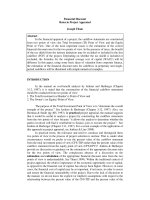Essential formulae in project appraisal
Bạn đang xem bản rút gọn của tài liệu. Xem và tải ngay bản đầy đủ của tài liệu tại đây (227.44 KB, 25 trang )
Chapter 5: Essential Formulae
in Project Appraisal
A Coverage of the Formulae and
Symbols Used to Evaluate
Investment Projects
1
Study objectives
After studying this chapter the reader should
be able to:
2
Apply a discounting rate to cash flows occurring at different points
in time to translate them into a common measure of value
Calculate present value, net present value (NPV) and internal
rate of return (IRR) from a given cash flow series
Calculate monthly loan (mortgage) repayments, their interest and
principal components and the loan balance of a mortgage loan
Understand the financial mathematics involved in the discounted
cash flow techniques (such as NPV and IRR) and mortgage loans
Apply the relevant annuity formulae for project appraisal
Internal rate of return
3
The internal rate of return is an alternative
measure for evaluating projects.
It is the calculated rate of return (or discount
rate) r at which the NPV will be equal to zero.
In project evaluation this rate has to be equal to
or greater than the required rate of return for
the project to be acceptable
It is calculated manually by trial and error, or by
a special routine in computerized spreadsheets.
Internal Rate of Return: IRR
0
1
2
CF0
Cost
CF1
CF2
Inflows
3
CF3
IRR is the discount rate that forces
PV inflows = cost. This is the same
as forcing NPV = 0.
4
NPV: Enter r, solve for NPV.
n
CFt
= NPV .
∑
t
t = 0 (1 + r )
IRR: Enter NPV = 0, solve for IRR.
CFt
∑
t = 0.
t = 0 (1 + IRR)
n
5
What’s Project N’s IRR?
0
IRR = ?
-100.00
PV1
PV2
PV3
0 = NPV
1
2
3
10
60
80
Enter CFs in CFLO, then press IRR:
IRRN = 18.13%.
6
Internal Rate of Return: IRR
7
Arriving at the IRR solution will involve
a number of iterations, so where there
are more than two cash flows, a
computer package (such as Excel) or a
financial calculator (with an IRR
function) is recommended.
Internal Rate of Return: IRR
8
In the NPV model, the NPV is clearly defined.
In the IRR equation, however, it is difficult to
define IRR in its own terms, because it
effectively means something like: ‘the rate of
return at which all funds, if borrowed at the IRR,
could be repaid from the project, without the
firm having to make any cash contribution’.
The IRR criterion does not measure the
project’s contribution to the firm’s value.
Internal Rate of Return: IRR
Example 5.14
Net cash inflows of a project are estimated
as: EOY 1 $3,000; EOY 2 $4,000; and EOY 3
$8,000. Capital outlays for the project will
occur during the first and second years and
they are estimated as $2,000 and $1,500,
respectively. They are assumed to occur at
the beginning of each period. The timing
notation for the correct discounting of these
will be: EOY 0 $2,000; and EOY 1 $1,500. The
discount rate is 10% per annum.
What is the IRR?
9
Internal Rate of Return: IRR
10
IRR = 133.76%
What is the payback period?
The number of years required to
recover a project’s cost,
or how long does it take to get the
business’s money back?
11
Payback for Project N’s
(Long: Most CFs in out years)
0
1
CFt
-100
Cumulative -100
PaybackL
12
= 2
2
10
-90
+
30/80
2.4
60 100
-30
0
3
80
50
= 2.375 years
Project M’s (Short: CFs come quickly)
0
CFt
-100
Cumulative -100
PaybackS
13
1.6 2
3
70 100 50
20
-30
40
1
0 20
= 1 + 30/50 = 1.6 years
Strengths of Payback:
1. Provides an indication of a
project’s risk and liquidity.
2. Easy to calculate and understand.
Weaknesses of Payback:
1. Ignores the TVM.
2. Ignores CFs occurring after the
payback period.
14
Evaluation of Project Cash Flows.
15
Cash flows occurring within investment
projects are assumed to occur regularly, at the
end of each year.
Since they are unlikely to be equal, they will
not be annuities.
Annuity calculations apply more to loans and
other types of financing.
All future flows are discounted to calculate a
Net Present Value, NPV; or an Internal Rate of
Return, IRR.
Decision Making With Cash
Flow Evaluations
If the Net Present Value is positive,
then the project should be accepted.
The project will increase the present
wealth of the firm by the NPV amount.
If the IRR is greater than the required
rate of return, then the project should
be accepted. The IRR is a relative
measure, and does not measure an
increase in the firm’s wealth.
16
Calculating NPV and IRR With
Excel -- Basics.
1.
2.
3.
4.
17
Ensure that the cash flows are recorded
with the correct signs: -$, +$, -$, +$ etc.
Make sure that the cash flows are evenly
timed: usually at the end of each year.
Enter the discount rate as a percentage,
not as a decimal: e.g. 15.6%, not 0.156.
Check your calculations with a hand held
calculator to ensure that the formulae
have been correctly set up.
Calculating NPV and IRR With
Excel -- The Excel Worksheet.
18
Calculating MIRR and PB With
Excel.
Modified Internal Rate of Return – the
cash flow cell range is the same as in the
IRR, but both the required rate of return,
and the re-investment rate, are entered into
the formula: MIRR( B6:E6, B13, B14)
Payback – there is no Excel formula . The
payback year can be found by inspection
of accumulated annual cash flows.
19
ARR and Other Evaluations
With Excel.
Accounting Rate of Return – there is no Excel
formula. Average the annual accounting income
by using the ‘AVERAGE’ function, and divide by
the chosen asset base.
Other financial calculations – use Excel
‘Help’ to find the appropriate function. Read
the help information carefully, and apply the
function to a known problem before relying
on it in a live worksheet.
20
Calculating Financial Functions
With Excel -- Worksheet Errors.
Common worksheet errors are:
Cash flow cell range wrongly specified.
Incorrect entry of interest rates.
Wrong NPV, IRR and MIRR formulae.
Incorrect cell referencing.
Mistyped data values.
No worksheet protection.
21
Calculating Financial Functions
With Excel -- Error Control.
Methods to reduce errors:
Use Excel audit and tracking tools.
Test the worksheet with known data.
Confirm computations by calculator.
Visually inspect the coding.
Use a team to audit the spreadsheet .
22
Essential Formulae -- Summary
1.The Time Value of Money is a cornerstone
of finance.
2. The amount, direction and timing of cash
flows, and relevant interest rates,
must be carefully specified.
3. Knowledge of financial formulae is
essential for project evaluation.
23
Essential Formulae -- Summary
4. NPV and IRR are the primary
investment evaluation criteria.
5. Most financial functions can be
automated within Excel.
6. Spreadsheet errors are common. Error
controls should be employed.
24
Essential Formulae -- Summary
7. To reduce spreadsheet errors: -document
all spreadsheets, keep a list of authors and
a history of changes, use comments to
guide later users and operators.
8. Financial formulae and spreadsheet
operation can be demanding. Seek help
when in doubt.
$ % $ % $ % $ % $ % $ % $ % $ % $ %$
%
25









